
The Treasurer insists it’s a tweak, a refresh, a directive for the world we live in today and perhaps a move predecessors Paul Keating or Peter Costello could have executed without public consternation.
In any case, the semblance, real or not, of our sovereign wealth fund’s prized innocence is no more, as an activist custodian grabs another lever of influence.
Along with its customary asset classes – cash, bonds, shares and property – the fund will be required to prioritise investments in housing, renewable energy and infrastructure, areas at the core of Labor’s agenda.

In Greg Combet, the government has elevated a like-minded soul to steer the transition to these worthy causes for a political movement that has lost faith in the power of free markets. The creep of big government and a quarter trillion in savings – what could possibly go wrong in Anthony Albanese’s opportunity society and Chalmers’ grand designs?
At the beginning of last year, the Treasurer produced a manifesto for a post-pandemic era, pledging to renovate energy, finance, labour and social services markets for a “values-based capitalism”.
“How do we build this more inclusive and resilient economy, increasingly powered by cleaner and cheaper energy?” he wrote in a 5600-word essay in The Monthly. “By reimagining and redesigning markets – seeking value and impact, strengthening safeguards and guardrails in areas of unchecked risk. And with co-ordination and co-investment: recognising that government, business, philanthropic and investor interests and objectives are increasingly aligned and intertwined.”
Critics saw this as the revival of corporatism at best, crony capitalism at worst, yet in keeping with the spirit of an age where many voters had lost faith in democracy and free enterprise.
Chalmers declared the free-market policy consensus over two generations had failed, with stagnant incomes behind the rise of political populism, and a new order was required. Labor would put fairness at the centre of a plan to redistribute wealth and opportunity, with the government as the engineer of national prosperity, in partnership with business, unions and community groups.
The Treasurer regularly convenes investor roundtable meetings, bringing together major banks, super funds and strategic industry players in energy, defence and manufacturing. Over its first 30 months, the Albanese government has made significant steps to reassert its control over what left-wing academics have called the “commanding heights of the economy”.
Labor has variously empowered trade unions in its re-regulation of the workplace, boosted social welfare spending, revived industry policy, put clamps on gas producers and, in the absence of a carbon-pricing mechanism, used regulation and taxpayer funds to accelerate the transition to renewable energy.
As a decade of projected budgets deficits suggest – due to rising health, aged care, debt-interest, defence and National Disability Insurance Scheme cost – Australia is becoming more expensive to run.
One area of bureaucratic bloat is the so-called “care economy”, a traditional Labor and union stronghold, accelerated by the ageing of the population.
The Albanese government has expanded the footprint of the state, with employee expenses rising by 9 per cent last financial year to $49bn, reflecting more public servants and wage rises.
Canberra’s spending on social benefits for health, aged care, disability services, childcare and family payments increased by 16 per cent last financial year to $152bn, after a 9 per cent rise in its first year in office. But there’s a large part of the action occurring now “off-budget”, as a new Centre for Independent Studies paper from economist Gene Tunny details, with state and federal governments planning to spend $100bn over the next four years.
“This trend reflects increasing government intervention in the economy, often through activist industrial policies that often end up picking losers rather than winners,” Tunny says.
The federal government has just launched a $36m advertising campaign for its Future Made in Australia program, the $22.7bn over a decade passion project Chalmers once said was “in lots of ways the Prime Minister’s reason for being”.
As the global trading system fragments – and economists warn of a “doom loop” as the big players impose tariffs – Chalmers is trying to make the security case for Labor’s approach as “derisking” our exposure and arguing guardrails are in place to make sure only significant projects are supported.
The business lobby is alive to the pitfalls of this approach but many senior leaders believe the nation is at risk of capital flight because of uncompetitive tax rates, clean energy subsidies in Asia, Europe and America, and over-regulation.
In April, Productivity Commission chair Danielle Wood warned that Labor’s signature program of industry grants and subsidies would divert investment from more productive parts of the economy and lead to higher-than-necessary costs for taxpayers.

Traditionally averse to handing over cheques to private businesses, especially in areas where there is a glut of world supply such as solar panels, Treasury has insinuated itself into the screening process; private capital doubts the bureaucracy has the expertise. This week the government announced its first investment from the $15bn National Reconstruction Fund, its primary vehicle to rebuild Australia’s industrial base, a $40m equity injection into a Queensland resources equipment manufacturer.
Naturally, business leaders further up the technology value chain were left wondering about where the capital market failure was in this instance.
A year after the NRF was established, one CEO told The Australian the clock was ticking to a federal election and any project in regional Queensland delivers a very big tick from a state where Labor holds few seats. Just a coincidence: it’s the home state of Labor’s coming man, who is pulling levers and refreshing mandates while rebuilding what he says is a more green-friendly, inclusive capitalism.







Jim Chalmers’ hands-on mission to remake capitalism has taken a risky if inevitable turn with the Future Fund’s investment mandate reset to serve Labor’s more interventionist approach to the economy.